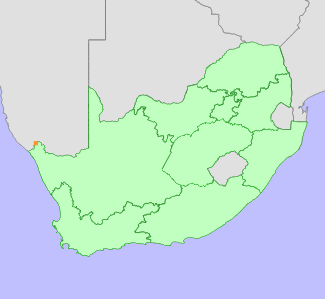|
Scientific Name | Anacampseros variabilis Poelln. |
Higher Classification | Dicotyledons |
Family | ANACAMPSEROTACEAE |
Synonyms | Avonia variabilis (Poelln.) G.Will. |
National Status |
Status and Criteria | Critically Endangered A2ac; B1ab(ii,iii,v)+2ab(ii,iii,v); C2a(i,ii); D |
Assessment Date | 2021/03/22 |
Assessor(s) | P.C.V. Van Wyk & H. Mtshali |
Justification | This species is known from only one location in South Africa, where it has an extent of occurrence (EOO) and area of occupancy (AOO) of less than 10 km². Between 80 and 90% population reduction was observed to take place from 2005 to 2018 due to droughts, mining and grazing activity (generation length 15-20 years). This species is known from a single population with less than 50 individuals, decline is ongoing. It is therefore listed as Critically Endangered under criteria A, B, C and D. |
Distribution |
Endemism | South African endemic |
Provincial distribution | Northern Cape |
Range | This species is known from lower Gariep Valley in the Northern Cape and it possibly extends to Namibia but there are no records to confirm its occurrence. |
Habitat and Ecology |
Major system | Terrestrial |
Major habitats | Western Gariep Hills Desert |
Description | It grows on quartz, pebbly pavement depressions. |
Threats |
| The site where this species occurs is heavily impacted by mining (dust from trucks, and prospecting driving through vegetation). It is also negatively impacted by livestock grazing activity. Its habitat of quartz overlying clay is very sensitive and when disturbance takes place the habitat degrades quickly and plants are negatively affected. The site was badly impacted by overgrazing, mining activities and droughts between 2005 and 2020. Death of between 80-90% of all individuals of this species was noted in 2018 (Raimondo pers. obs.). |
Population |
This species is known from a single subpopulation where there are less that 50 extant individuals. The population has been observed to decline by 80% over the past one generation (15-20 years). It continues to decline due to extended drought conditions coupled with ongoing mining and grazing activity. Surveys are urgently needed to determine whether any other subpopulations remain.
|
Population trend | Decreasing |
Assessment History |
Taxon assessed |
Status and Criteria |
Citation/Red List version | | Anacampseros variabilis Poelln. | Least Concern | 2015.1 | | Avonia variabilis (Poelln.) G.Will. | Least Concern | Raimondo et al. (2009) | |
Bibliography |
Raimondo, D., von Staden, L., Foden, W., Victor, J.E., Helme, N.A., Turner, R.C., Kamundi, D.A. and Manyama, P.A. 2009. Red List of South African Plants. Strelitzia 25. South African National Biodiversity Institute, Pretoria.
Snijman, D.A. 2013. Plants of the Greater Cape Floristic Region 2: The extra Cape flora. Strelitzia 30. South African National Biodiversity Institute, Pretoria.
|
Citation |
| Van Wyk, P.C.V. & Mtshali, H. 2021. Anacampseros variabilis Poelln. National Assessment: Red List of South African Plants version 2024.1. Accessed on 2025/11/11 |
 Comment on this assessment
Comment on this assessment

